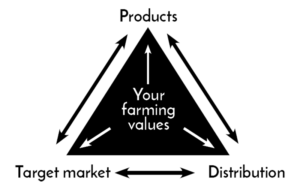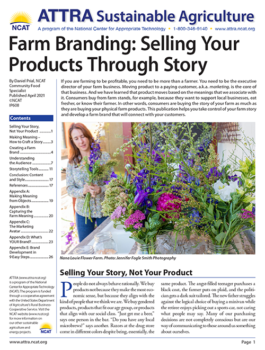Farm Branding: Selling Your Products Through Story
By Daniel Prial, NCAT Community Food Specialist
Abstract
If you are farming to be profitable, you need to be more than a farmer. You need to be the executive director of your farm business. Moving product to a paying customer, a.k.a. marketing, is the core of that business. And we have learned that product moves based on the meanings that we associate with it. Consumers buy from farm stands, for example, because they want to support local businesses, eat fresher, or know their farmer. In other words, consumers are buying the story of your farm as much as they are buying your physical farm products. This publication helps you take control of your farm story and develop a farm brand that will connect with your customers.
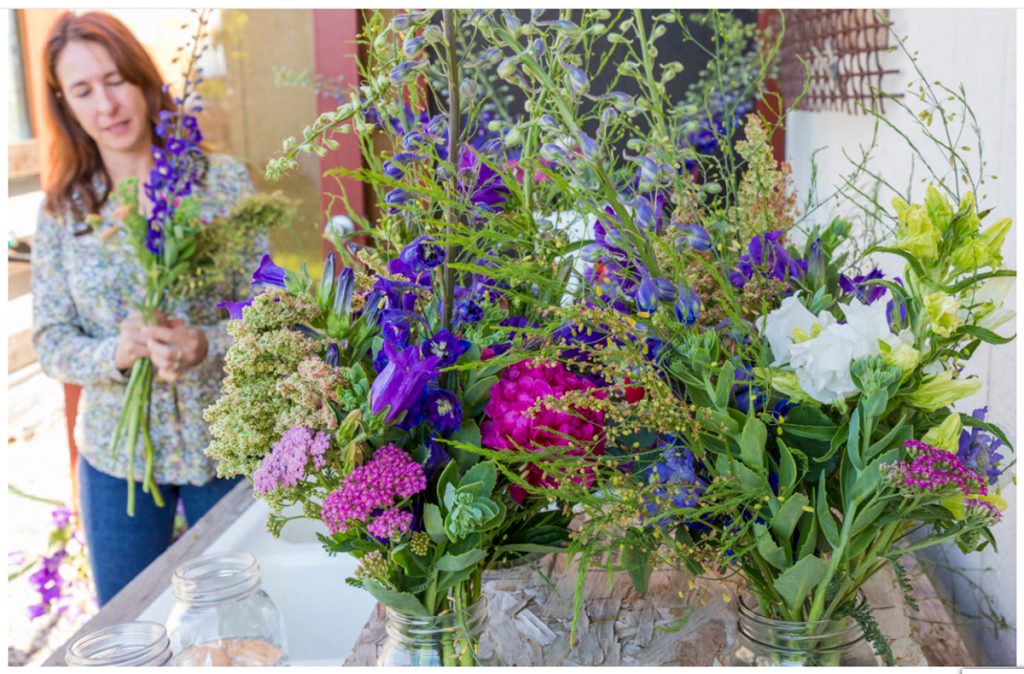
Nana Louie Flower Farm. Photo: Jennifer Fogle Smith Photography
Contents
Selling Your Story, Not Your Product
Making Meaning – How to Craft a Story
Creating a Farm Brand
Understanding the Audience
Storytelling Tools
Conclusion: Content and Style
References
Appendix A: Making Meaning from Objects
Appendix B: Capturing the Farm Meaning
Appendix C: The Marketing Avatar
Appendix D: What’s YOUR Brand?
Appendix E: Brand Development in 9 Easy Steps
Selling Your Story, Not Your Product
People do not always behave rationally. We buy products not because they make the most economic sense, but because they align with the kind of people that we think we are. We buy gendered products, products that fit our age group, or products that align with our social class. “Just get me a beer,” says one person in the bar. “Do you have any local microbrews?” says another. Razors at the drug store come in different colors despite being, essentially, the same product. The angst-filled teenager purchases a black coat, the farmer puts on plaid, and the politician gets a dark suit tailored. The new father struggles against the logical choice of buying a minivan while the retiree enjoys picking out a sports car, not caring what people may say. Many of our purchasing decisions are not completely conscious but are our way of communicating to those around us something about ourselves.

Eco City Farms outside of Washington, DC, welcomes visitors to their urban location with their logo, a tagline, and all the contact information they would need. Photo: Daniel Prial, NCAT
The science behind this reached its stride in the 1960s. Sidney Levy published his article “Symbols for Sale” in the Harvard Business Review, describing how customers do not buy for economic reasons. Instead, we buy for the symbolic meaning of a product (Levy, 1959). For example, my favorite brand of peanut butter might not stand up to a taste test, but I buy it because it has labels and words that I connect with: organic, natural, additive-free.
As such, although folks may buy your farm product for many stated reasons: taste, convenience, supporting their local farmer, etc., your customers are buying a means of confirming their own identity and self-image. Your job as a marketer, therefore, is to sell your customers the symbols, or rather, a story they can connect with. When the story of your product aligns with your customers’ story about themselves, they make the purchase (Sirgy, 1982).
Before getting too far ahead of ourselves, it is worth remembering that, depending on the size of your operation, most readers of this publication are balancing marketing with other crucial jobs on the farm, such as production and bookkeeping/finances. Plus, you are likely pushing the envelope in both of those categories: sustainable and regenerative production methods, and creative financial decisions. This publication hopes to make branding easy – something you can prepare during the off-season and follow through as harvests come in and sales go out.
Key to branding is the fact that you control your story at all levels, from your logo design to your font choices to the kind of rubber band you use around a bunch of radishes. This publication will help you learn to direct that story through a series of exercises that will ultimately help you design your farm brand. Your farm brand is the overarching story told by you, your products, and your farm.
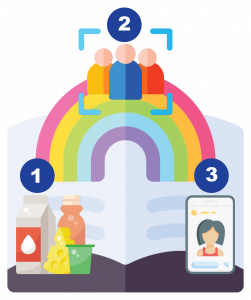 The Parts of a Story
The Parts of a Story
In order to tell a story successfully, you need to consider three elements: the subject, the audience, and the method.
-
- The Subject – What are you telling? What is the content? In this case, the subject is your farm, your farm products, and your farm story.
- The Audience – Who are you telling the story to? What do you know about them? What are they wanting to hear? How are your different audiences connected to different products or different facets of your brand?
- The Method – How are you going to tell the story? What techniques will you use to convey information about the subject to the audience?
From here, we will work our way through these three elements, in order, starting with how to make meaning – the heart of a story. Then, with “Creating the Farm Brand,” we will discuss the subject: your farm. What are the elements of the story that you wish to tell? Continuing with “Understanding the Audience,” we will build knowledge of the folks you are trying to sell your farm brand to and learn what to do to tell them the story they are interested in hearing. Finally, with “Storytelling Tools,” we will look at the techniques that convey the farm brand: from the obvious, such as the farm name and logo, to the less obvious, such as labels and color choices.
Making Meaning – How to Craft a Story
The goal of farm branding is to convey your farm story. Your farm story will give meaning to your products. Meaning answers the question “so what?” and gives the customer the reason to make a purchase. No matter what you are selling—food, fiber, materials, etc.—you need to differentiate yourself from your competitors. Differentiation comes from meaning.
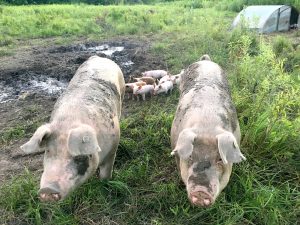
Pasture-raised pigs raise their young in the open air. Archway Farm, Keene, NH. Photo: Daniel Prial, NCAT
Another way of thinking about this is a farmer trying to sell peaches. As a commodity, peaches are less than a dollar a pound and can be found in any grocery store during the right season. Selling peaches through meaning (“locally grown,” “tree-ripened,” “woman-run business,” “take a bite of summer,” “fresh from your neighbor”) differentiates your product and almost always allows you to command a higher price in the marketplace. Not differentiating your product puts you in the same category as commodity growers who operate on a completely different scale. Not differentiating your product could mean not staying in business.
Let us look at the fictitious examples of Argyle Farm and Batik Farm. Both are small farms in the same town. They raise pigs and sell pork. They buy from the same feed store and send their pigs to the same slaughterhouse. Their costs are pretty much the same and their prices similar. Avid fans will say one product tastes better, but no one has done a blind taste test. How do they differentiate? Argyle Farm has an old-fashioned logo and talks about the family being on the same land for 150 years. Batik Farm has a strong social media presence and tucks a multicultural fusion recipe in with every sale. Their stories evoke tradition and hipness, respectively. Folks wanting to identify with Argyle Farm’s story of belonging, community, and history shop at Argyle Farm. Folks wanting to identify with Batik Farm’s story of looking forward, culture, and experimentation shop at Batik Farm.
One method of creating meaning is to draw out the intangible elements from tangible objects. It is looking at an object and asking, “So what?” For example, a shovel is a tangible object, but a shovel can represent many intangibles: digging, searching, building foundations, unearthing, and more. Fans of conservationist Aldo Leopold will remember from the essay “Axe-in-Hand” that Leopold connects the shovel to the act of planting trees and connects the ax to the act of chopping them down. “Whoever owns land has thus assumed… the divine functions of creating and destroying plants” (Leopold, 1949). In this example, Leopold has given a simple object of wood and metal the powerful meaning of creation.
Definitions: Tangible vs. Intangible
Tangibles are objects that we can interact with using our five senses: sight, smell, taste, touch, and hearing.
Intangibles are abstract and include ideas, values, feelings, emotions, processes, systems, events in the past or future… the list goes on.
Turning this activity toward farming, let us use kale as an example. As a tangible, kale is a plant of so many inches tall, bitter taste, etc. Not to knock kale too much, but there is a reason why it needed a large marketing campaign: on its own, it easily loses in taste tests to every other brassica, right?

Kale raised in a workplace community garden and donated to a local food bank. Photo: Daniel Prial, NCAT
The meaning of kale is where the plant gets is power. Kale is rich in vitamins and an important source of fiber, minerals, and antioxidants. Fiber and antioxidants are important in combating diabetes. The potassium in kale can help combat heart disease. And some studies even suggest that compounds in kale will help flush the body of carcinogens from red meat. So, throw some kale on that burger! (Medical News Today, 2020). Simply put, kale is nutritious. That nutrition is a powerful meaning attached to the product.
In addition, the farmer knows that it grows easily, is very hardy, and can be harvested all season. Therefore, it can be an inexpensive source of nutrition. The story of kale gets richer.
Give the exercise in Appendix A, “Making Meaning from an Object,” a try.
Once you have the feel for making meaning out of objects, it should come quickly. Humans have been attaching meaning to objects as long as there has been civilization. A circle of shiny metal is nothing special. But on the head of a ruler, it becomes a crown and a symbol of authority.
For more examples of making meaning out of objects, look at how advertisers make commercials. The meaning and story behind Budweiser beer usually has little to do with how it’s made and everything to do with Americana, the image of an American farm (man clad in plaid with a chiseled jaw and a dog), and tradition. Coors beer has a story that connects to the fresh cold of mountains, ice, and snow. Car companies will evoke meanings of power, status, luxury, family, and more. Banks tell stories of community, reliability, and safety.
Creating a Farm Brand
The farm brand is the story that sits like an umbrella over all of your individual products. It is the personality of your farm and it affects what you do and how you do it. Let’s go back to the fictitious Argyle Farm and Batik Farm examples and see how the brand affects what they do:
| Argyle Farm | Batik Farm | |
| Logo | In the style of a woodcut | Post-modern chic |
| Farm Stand | Mostly wood paneling, unadorned, tin can money jar | Tie-dye wall hangings, world music, takes online payments |
| Packaging | Plastic packaging from slaughterhouse | Wrapped in recycled newsprint and packed with new-age recipe |
| Tagline | “Growing Quality Pigs Since 1923” | “Bacon for the soul” |
To create a farm brand, the idea is to pull intangibles out of the farm the same way you pull intangibles out of a product to sell it. Working at this level brings out all sorts of complications, however. How do you answer, “So what?” for an entire business? To help answer this question, below are four different techniques to use in developing a farm brand. Pick one and give it a try. Combine the answers with another activity and see how things change.
One note: brand, like a person’s identity, is an evolving and changing thing. Writing up a brand document can be a powerful way to explore these ideas and share them with family members and employees. Like other planning documents, it can be helpful to revisit from time to time.
Your brand is more than just designing a logo or writing a catchy slogan. Your brand is not your product or even your farm. Your brand is your reputation. –Erin Flynn, marketing expert and organic farmer, Green Gate Farms
Source: Beyond Fresh: A Food Processing Guide for Texas Farmers, an ATTRA publication
Whole-Farm Planning
If you have done whole-farm planning for your business, one good place to start with your brand is the answers you developed for your farm goals. Why you farm could be a reason that someone would connect with your farm.
Whole-farm planning asks a farmer to be introspective and pull a farm mission from values, history, and goals. Ask yourself: what is your personal and family history? What are your personal and family values? What goals do you have for yourself and your family? What are your farming dreams? What skills do you bring to farming? What financial needs are you trying to meet through farming?

A free-ranging, pastured-raised pig of Archway Farm, Keene, NH. Photo: Daniel Prial, NCAT
For more information on whole-farm planning, you can talk to ATTRA specialists or contact your state university Cooperative Extension service.
For the purposes of farm branding, focus on your “why” of farming. Pull out those explanations and see if you can turn them around for a potential customer. For example, a fictitious Alex farms medicinal herbs because she sees the power in natural healing. She can build a brand around that.
The Farm Story
Take a moment to write out the farm story. How did you get started? Why did you get started? Who was involved? How did the name come about? What was the first farm product? Find a relaxing spot, take your time and let the words flow. There is no need to start editing at this point. Write down everything that comes to mind.
After some time has passed, go through what you have written and underline what resonates with you. Pull out words and ideas that you feel are important. Then refine. Can ideas be combined? Ranked? What is most important? Sleep on it and try again. This refining will result in a few ideas that you can use for marketing.
For example, maybe you realize that the moment the 1980s John Deere tractor arrived on the farm was the major turning point for you, and you decide to make it into the farm logo. The farm stand gets decorated with steel in green and yellow and you embrace ’80s fonts and styles.
Maybe, in looking over the farm story, you realize that a motif of friendship appears repeatedly. Friends helped you put up the down payment on the land. Friends helped you plant the first crop. Friends celebrated the first harvest. You go to a graphic designer and say: how do I incorporate this into my brand? The designer turns your old logo around to include a stylized symbol of friendship.
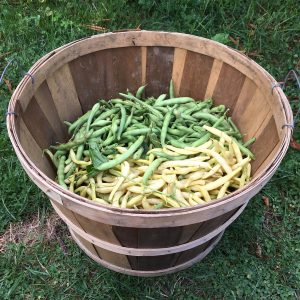
These beans could be described as ‘organic,’ ‘hand-picked,’ and ‘grown for a food bank.’ The farm that raised them can adopt those adjectives into its farm brand: ‘organic’ ‘grown by hand,’ and ‘giving back to the community.’ Photo: Daniel Prial
If the Business Were a Person…
For some folks, it might be helpful to personify the business. What would your farm be if it were a person? Would your farm be a weathered old man in torn clothes with a big smile on his face? Would your farm be a strong dairy lass holding baby goats in her arms? How about a friendly drinking buddy? Or a comforting parent?
Personifying the farm like this can help you get a sense of the image you want to convey. Pull out “personality” characteristics and list them: friendly, quaint, hip, fun-loving, etc. Narrow the list down to the top few. When making branding decisions, refer to those key words.
Regarding farm personality, it is probably a good idea for your farm personality not to be too far from your own personal identity. In other words, if you are an Argyle Farm, fifth-generation kind of farmer using the same techniques that your great grandfather used, it is not going to be as easy to brand yourself as a new up-and-comer. (Of course, there is always a counter-factual, and the rise of hipster “old is cool” culture comes into play here.) The important part is to be true to yourself, as that will create an authentic farm brand.
Adjectives
One more way to help define the farm brand is to list two or three adjectives that you want to describe your farm. Of course, as with everything, it is more complicated than it sounds. And please note that this method overlaps very nicely with the other techniques.
The idea here is to take some time and write down all the adjectives (and adjectival phrases) you could use to describe your farm: open, reliable, community-minded, next door, full-service, organic, humane, veteran-owned, woman-owned, immigrant-owned, and so on. For the more tactile learners, write each one on a sticky note or piece of paper and spread them around the table or wall.
Over time, see what words overlap and what words you keep coming back to. You may have a women-owned farm, but it might be more important to you that the farm has a “next-door feel.” Your farm may be certified organic, but it might be more important that it is reliable.
Put the Farm Brand in Writing
There are infinite ways to codify the farm brand and story, but do whatever works best for you and the people you work with. You might end up with one or two pages in the front of the farm binder. You might have a poster by the pack station or the computer. The important thing is that you can return to these thoughts and refer to them, change them, and share them with others.
Do I really need to think about branding?
From Beyond Fresh: A Food Processing Guide for Texas Farmers
In a word, Yes. You do. Before explaining why, let’s review three big reasons why farmers tend not to invest much energy into branding.
1. “I don’t need to do this…”
- I’ve been coming to market the longest.
- Mine looks best.
- I work harder than other farmers.
- My customers love me.
- My products will sell themselves.
- The quality of my products will speak for itself.
2. “I can’t do this…”
- I don’t know the first thing about it.
- I’m not creative, artistic, or good with words.
- It feels strange and uncomfortable.
- I’ll make a fool of myself if I try.
- I’m too humble and modest to brag about my products.
3. “It’s a betrayal of my values for me to do this…”
- I’m all about substance, not style.
- It’s beneath me.
- It’s distasteful.
- It makes me feel dirty.
- It seems dishonest.
- It’s not what I signed up for when I started farming.
As advocates for the Farmer-First perspective, we sympathize with all of these reactions. Farming is not just about making money… And yes, marketing should be honest and transparent. But here’s the problem: Every business has a brand. And if you don’t create one for your business, your customers, the media, your competition, and other influencers will create one for you. If you just let your product speak for itself, it may not be saying what you think it’s saying.
Understanding the Audience
Returning to our starting point: your customers are building their identities with your brand. They are using your brand to make a statement to those around them. They are, in a sense, wearing your farm brand in the same way that they might wear clothing that displays a Carhartt logo or a Calvin Klein logo.
Now that you’ve established the story that you want to tell, you need to understand the folks who will want to hear it. Not everyone goes for a romantic comedy at the movie theater, and not everyone will want to buy your free-range broilers. Do not fall in the trap that your farm can sell to “everyone.” You will wind up watering down your identity and end up having a brand that does not carry meaning. Folks will have no reason to purchase your brand or your products.
To find your target audience, find the folks who have similar identities and values. Find the folks who want to be like you.
Target Market
There are many tools out there for finding target audiences, available both online and from business development agents, such as your local Small Business Development Center. You should consider having a few different and unique target audiences. Don’t try putting all your sales in one basket.

Do your customers know the difference between ‘free range’ and ‘Freedom Ranger’? Do they need to? Do you need to tell them? These Freedom Rangers are from Black Dog Farm, Livingston, MT. Photo: Daniel Prial, NCAT
One tool that can be useful for developing target audiences is called a marketing avatar. This avatar will represent a specific customer and serve as a focal point for your marketing thoughts. Appendix C is a worksheet for creating a marketing avatar. Make a few copies of it before you begin.
As you fill out the worksheet, think about a specific person, or make up a specific person who would want to buy from your farm. Maybe take a customer who has shopped with you since the day you opened for business. Put down on the worksheet everything you know about the person demographically, but really focus on that person’s identity. What are this person’s goals and values?
This tool also asks you to consider the challenges your avatar faces in life. Classic marketing strategy has your product solving a problem for your customer. Farmer-first thinking, as this publication relies on, is more about sharing values than solving problems. If you can market to your customer in multiple ways, why not? The same applies to the barriers-to-sale section of your worksheet: what stops your avatar from making purchases from you and how can you mitigate that?
Sources of information are handy to consider because they help refine your advertising. You know that all your customers also shop at a local coffee shop? Well, no need to take out a newspaper ad. Just put up a sign in the coffee shop.
For best results, complete this activity three or four times with different avatars. Each avatar should represent a different target market you are trying to reach. For farms, the classic avatar is a mother, as mothers statistically still make most food purchases in this country. If you are selling direct to consumer, your avatar is probably middle-class or above and highly educated, plus she is predisposed to purchasing local, organic, etc. But also consider making an avatar for your local restauranteur who might buy your product. Talk to a local business-development assistant about other potential markets and avatars, for example the “LOHAS consumer,” which stands for Lifestyles of Health and Sustainability.
Try to expand your comfort zone with your avatar. You can imagine someone who uses SNAP benefits, who really wants high-quality food, but cannot necessarily afford it. You can imagine the older person, set in his ways, who always buys his food from the big box store. Again, if it helps, start with a real customer of yours and run that person through the avatar worksheet.
Sources for Marketing Data
You do not need to create these avatars completely from your own brain, however. Much of the data you would want, or need, is accessible to you through public sources.
The U.S. Census contains a wealth of information that can be sorted through down to roughly the county level. Do you want to know the education level of your potential customers? Their median annual earnings? How many of them are employed? How many people live in their homes? All this information is available to you for free.
The Census is only one potential source of information. The Small Business Administration has compiled a list of resources and recommends doing market research with the following organizations:
-
- North American Industry Classification System
- USA.gov Statistics Page
- U.S. Bureau of Labor Statistics, including:
- Consumer spending statistics
- Demographics of the labor force
- How people use their free time
Focus Discussion: Values-Based Marketing and the Farmer-First Approach
Classic marketing theory suggests that you, as the producer of a product, should be answering the needs of your customer. As your customer lies in bed at night, worried about the future, your product should be the answer. Problem–Solution.
An example of this could be the young mother who is worried about the effects of organophosphates on the brain of her developing child. She desperately wants to purchase certified organic food. Your organic vegetables are a solution to her problem.
The ATTRA resource, Beyond Fresh: A Food Processing Guide for Texas Farmers, explores the idea of a “Farmer-First” approach to marketing:
Taking a Farmer-First approach means you are going to start with what YOU want, the products YOU can make—comfortably, easily, enjoyably, and consistent with your farming values. THEN you are going to ask if any of these products can be sold profitably, and to whom.
The Farmer-First perspective is basically about setting boundaries—as you have every right to do. Selling is not just about what the market wants but is more like a three-sided triangle. Your target market is driven by the products you decide to make. Your decision about what product to make is heavily influenced by the distribution channel you choose, as well as your farming values. And your choice of distribution channel depends on your target market. All these factors influence the others. You need to hold them all in your head at the same time and bring them into balance. If they won’t balance, you’re going to move on and think of something else to do. (Beckwith and Morris, 2019)
Couple this Farmer-First mentality with the idea that folks are buying your product to communicate their identity. You end up with a set of symbols that have meaning to the farmer and have meaning to the customer. For example, a farmer values humanely raising animals and becomes Certified Humane. The connected customer values animal welfare and shows that value by purchasing the farmer’s product.
What we end up with is a positive coming together of values. Instead of a Problem –Solution mentality, it’s Values-Based Marketing.
This is not suggesting that Values-Based Marketing is better than Problem–Solution Marketing. In fact, it may make sense for a farm, for example, to market its CSA share as solving the problem of feeding a family and as the value of building community.
Values-Based Marketing is still a discussion topic amongst marketing professionals. An Internet search shows a variety of articles with positive and negative arguments, as exemplified by an article in Marketing Dive some years back (Angulo, 2015).
However, when looking at the farm brand (as opposed to specific farm products), you will likely have more success connecting to your customers and potential customers if you put your focus on Values-Based Marketing. For more on this, jump to “Focus Discussion: Framing in the Brain and Why It Matters.”
Most importantly, you can do your own market research. Your current customers can be a wealth of information. While it is tempting to rely on a survey, there are many ways to collect data about what your customers value:
-
- Talk to them when they are making purchases from you. Ask them: What brought you by today? What is it about my products that you appreciate? What has made you such a loyal customer over the years? Write the answers down before you forget.
- Look at your own record books: What has consistently sold well? How did your sales respond to the changes you made? Do you see trends in the data, e.g., a surge around Thanksgiving?
- Create a focus group of some of your die-hard customers. Focus groups are good at getting in-depth answers to specific questions. Ask your group questions and let them, as a group, discuss the answers. Sometimes, folks will build off each other’s answers more than if you had just asked them directly. Keep a recording of the focus group or take diligent notes. Consider offering free product as payment for their time. One idea is to have the focus group at the farm and serve a buffet meal. Also, consider doing a focus group of non-customers, or infrequent customers – but this is significantly more challenging.
- Use surveys delicately and keep them short. Surveys of your customers can be helpful at getting a broader, more statistically significant perspective. Tip: you will get better responses if you can limit your questions to 10 or less. Also, give folks plenty of multiple-choice answers. Consider offering product as a reward for taking the survey.
Remember, all this work is trying to answer the question: what do my customers value? The goal of your market research is to align the values of your brand with the values of your customers.
Focus Discussion: Framing in the Brain and Why It Matters
More and more these days, communications experts have been pulling from linguists and psychologists and leaning heavily on the theory of framing. The basic idea is that our brains apply lenses to what we absorb. Everything that enters our brains is filtered through frames. These frames filter what we actually see and show us what we want to see. In other words, our built lifetimes of experiences tint our observations.
For example, we recognize even the most obscure breeds of dog or the most strangely designed cars because our brains have frames for understanding what a dog is and what cars are. As such, if we see something that looks like a car and we want to drive it, we have a general idea of how to drive that car based on our past experiences (Davey, 2008).
When it comes to your farm brand, it is important to remember that people already have a frame for what your brand might be. They watch television and expect all farms to be struggling (regardless of your personal bottom line). They look at history and associate the farmer with “simple people” (regardless of the myriad variables involved in agricultural science). In other words, there is a story already in people’s brains about what your farm is.
It is incredibly difficult to work around these frames, as facts and figures only do so much against a lifetime of lived experiences. You may not understand the physics behind planetary and stellar motion, but you know that the sun will rise tomorrow as it has every other day of your life. You may know that you are more likely to die in a car crash than an airplane crash, but that does not stop you from being nervous on an airplane.
Your customers have pre-existing frames around your farm products and brand. Does your customer know and understand the nuances of the regulations around the USDA National Organic Program? Likely not, but the frame of “organic” sticks in their brain and they have a story about what they think it means.
This means that for the most short-term marketing success, it pays to reach your customers through their frames. You can work to alter their frames over time, but in the short term, get to know how your customers see the world. Understand that New Englanders have a narrative about the importance of community and buying local.
Understand that the term “organic” is shorthand for “safe.” Understand that the term “humane” is not just a label, but a way to describe the care that the farmer puts into animals and work.
Values make frames. Branding to values helps supersede preconceived notions that customers have. Values help carry your brand, message, or product through a frame in your customer’s brain. For example, almost universally, humans value family. Many farms understand this and incorporate their families into their brand. “From our family to yours.” The farm brand is carried through a love of family.
Aligning Farm Brand with Customer Identity
Now that you have a better understanding of who your customers are, you need to take the first steps toward aligning your messaging. The goal is to make sure that your customers and potential customers can easily connect with parts of the farm brand. The next section of this publication discusses the tools to make this connection, but for now, we will address the connections’ foundations: the values.
The basic idea here is to place your farm identity and values on one side of a Venn diagram and the customers’ identities and values on the other side. Focus on the overlap: where will your customers and potential customers share your identities and values?
Our example from earlier of Argyle Farm, the fifth-generation hog farm, would write the following words on their side of the Venn diagram: tradition, family, community, quality, and dependability. They wrote up a marketing avatar for Frank. Frank is a second-generation carpenter in town and is known throughout the region for his skill. He values tradition and family. He supports small, independent businesses. He believes in independence and a cash economy. The folks at Argyle Farm see the identity and values overlap: family business and tradition. Based on his reputation, they know that Frank also values quality work, just like Argyle Farm. They focus their marketing messages, therefore, on those three key values.
Running through the same activity with three or so different marketing avatars will show that different customers choose your farm for different reasons. This is normal. Your brand is not static and will have different meanings to different people. Folks might choose Batik Farm (our other fictitious farm example) because they want to support young growers, or they might want to feel multicultural. Batik Farm looks for messaging that resonates with those varied meanings.
If you happen to discover that all of your customers resonate with one of your values, you have the opportunity to use it strongly in your messaging. It can become a core value. For example, “Argyle Farm Stands for Tradition” could be a tagline.
Throughout all of this work of values alignment, it is crucial to remember to stay authentic to yourself and your farm. Just because your customers or potential customers value something is not a reason to incorporate it into your farm brand. The same goes true for your competitors. Just because all the farms around you are showing pictures of their children in Instagram does not mean that you need to be a “family farm,” as well. Think of commercials you’ve seen of big corporations doing a public relations push: an chemical company saying how environmentally friendly it is or a fast-food company saying that it values quality. The commercials get negative responses because the business is trying to say something that is outside of or does not align with its brand.
Aligning values means starting with your values and connecting them to your customers and potential customers, not the other way round.
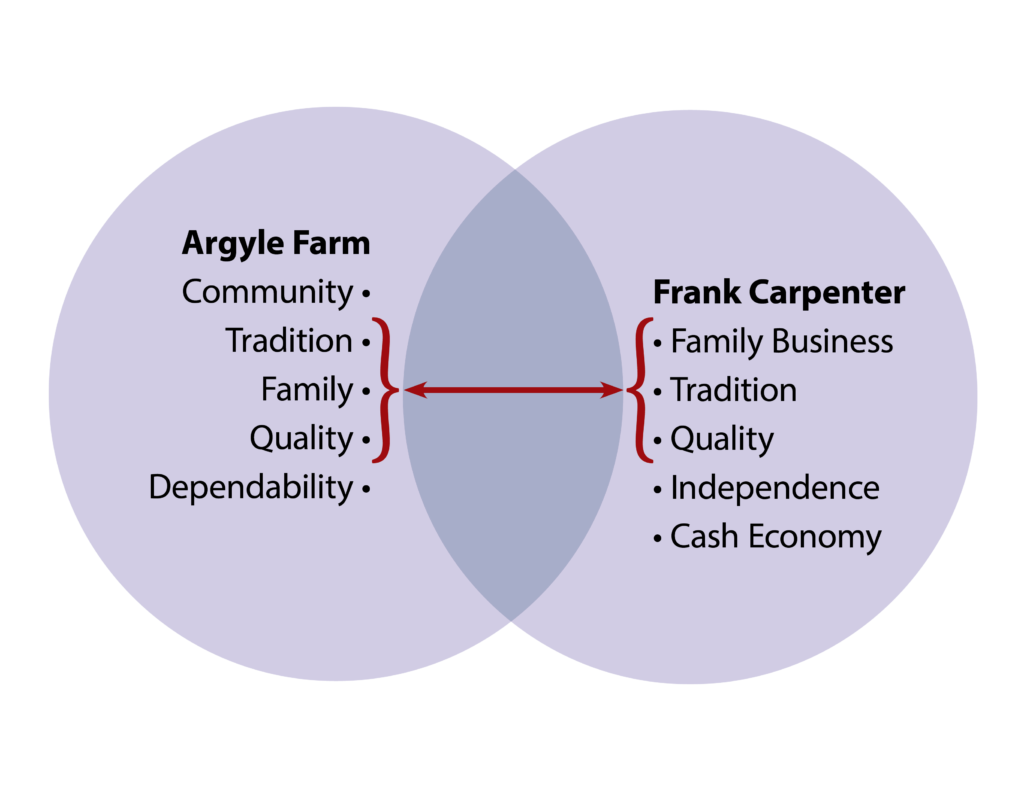
Where the values of Argyle Farm and the values of customer Frank Carpenter align is where Argyle Farm should put effort into its marketing. They can authentically market from their values and in a way that will be received positively by the customer.
Storytelling Tools
Before diving deeply into branding tools, it is worth noting that this section is not meant to be a comprehensive guide to branding. If the topic is something that interests you, use this as a starting point. This section is meant to be a discussion of different branding tools and how they can offer you a lens to think of your farm marketing. In other words, this publication will not be offering recommendations, but rather lessons from examples that may, or may not, apply to your farm.
The Farm Name
Perhaps more than any other branding tool, the farm name is the most direct way for you to share the farm brand. It might be displayed proudly on a sign at the side of the road, at the top of a farm stand, or at the top of a webpage. On the other hand, the name might be the only thing a customer knows about your farm. It might be written in small black letters on the bottom of a USDA slaughterhouse label that is otherwise generic. The farm name, standing all alone, is a powerful carrier for meaning.
Let us look at a couple famous names in farming circles: Polyface Farm and Four Seasons Farm. Just from their names alone, we get a sense that Polyface is going to be a diverse operation. The prefix poly means “many.” A farm named “many face” suggests that they have many different operations going on. Four Seasons Farm—just from the name alone—tells us that they are likely growing all year. In other words, they must have figured out how to grow during the winter.
And the names do, in fact, tell the full story. Polyface Farm is the home of Joel Salatin, who is famous for developing intense rotations of cows followed by chickens followed by crops. Four Season Farm is the home farm of Elliot Coleman, a vegetable grower who uses greenhouses to extend his Maine growing season throughout the year.
Tim Young of Small Farm Nation is a farm-marketing consultant who offers much of his material for free, online. He recommends that a farm name meet nine criteria. He balances several variables here, including brand recognition, digital marketing and online presence, fads and styles, and practicality. Not all the advice may pertain to your situation:
-
- Keep it short.
- Make it memorable. Young recommends unique names that are clever.
- Make it pronounceable. This piece of advice is going to be location-specific and dependent on your target market.
- Consider SEO (Search Engine Optimization). Your name should be easy for Internet search bots to find clear words, descriptive, perhaps include the farm product.
- Avoid hyphens. Online, hyphens can be confusing, especially in URLs.
- Avoid trendy words. If they go out of style, you might be stuck with an uncool name.
- Avoid limiting names. For example, Dana’s Lavender Farm is not the place you would expect to find pork, or an owner named Francis.
- Stay with your brand values. In other words, if you are going for tradition, use a traditional farm name.
- Double check that you can use it. It is going to be difficult if you pick a name only to find that the farm down the street has the same or a similar one. Also, make sure that you can get the Internet domain name for a website.
(List adapted from Small Farm Nation, How to Choose a Farm Name, by Tim Young)
One quick note: it is possible to change a farm name with a rebrand, but it can be difficult if customers have loyalty to the old brand. It is best to ask your core customers before doing anything as serious as changing a business name. For business paperwork purposes, it is usually as easy as filing a “Doing Business As” (DBA) with your state. Your farm would be “[old name] DBA [new name].
Above all, the farm name should not go against the brand as you have defined it.
Mission, Vision, Values
Mission, vision, and values are key terms in creating your farm business strategy. Without going into too much depth, mission is “what you do,” vision is “what impact you make,” and values are “how you do it.” You should already begin to see how they influence your brand. A small CSA farm with a mission of feeding the community envisions their town as a place where no one is hungry and places value on their economically priced membership and cost-assistance programs.
How you convey this information is tied up in your brand. Often, mission, vision, and values all boil down to a single tagline.
In this case, we are not referring to a specific tagline, but rather the idea of the farm brand summed up into its essence. This may be the one sentence that appears under your logo or on your website. Or it just might be the core principle that gets you out of bed in the morning.
Let us look at a couple of examples. We will return to Four Season Farm, which proudly proclaims on its website:
We farm the way ‘organic’ used to mean.
What does a statement like this tell you? What does it try to invoke? Elliot Coleman and his family, who believe deeply in the organic movement as more than just the USDA organic label, are trying to say that they have a higher standard for their production. They are trying to rouse the spirit.
Soul Fire Farm in upstate New York has a powerful tagline:
Ending racism and injustice in the food system.
They are saying that the products of their farm, the kale, the radishes, the classes, etc., are all unified by one purpose: an end to injustice. That is the meaning and the story of the farm. The farm, the kale, and the radishes carry that meaning along with the farm’s education and outreach programming.
In both cases, Four Season Farm and Soul Fire Farm integrated powerful meaning into simple words that are easy for their customers to understand. Their mission, vision, and values, i.e., their reason for being a farm, are clearly and concisely conveyed.
Logos
The farm logo is a powerful branding tool because it takes us out of the realm of language and into the world of art. Pictures can convey much more meaning than words. Symbols can connect our audience to deeper stories.
Let’s look at a few examples. The guiding question you should be asking yourself for each logo is: what story is it trying to tell?
Looking at the Echo Farm Puddings logo, ask yourself, what is important to this brand? What would you expect the farmers to be like if you were to meet them? What would you expect the pudding to taste like? What does the style of the artwork suggest to you? What emotional reaction do you have to the logo?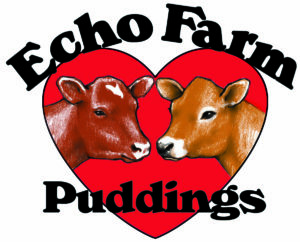
Now, look at the Archway Farm logo, and ask yourself what kind of message it sends. What sense do you get from the farm? What adjectives would you use to describe the farm? The farmer has made a choice here to not clearly define the product the farm produces. How does that open possibilities for the farm business? How does including the farm’s location on the logo affect your thinking about it? What if the logo had included “Established 2015,” or had a tagline? Again, ask yourself what emotional reaction you have to Archway Farm’s logo.
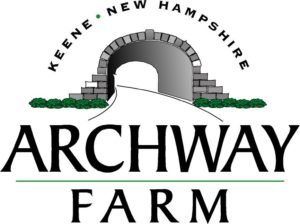
The logo for Three Sons Farmacy is simple: the three stars, the farm name, a location, and contact information. When you look at this logo, what feel do you get for the farm business? What’s important to the owners? What do they value? With logos like this, the font choice does a lot of the conveying of messaging. What does the font choice say to you? Like Archway Farm, Three Sons Farmacy has the location of the farm in the logo. How does that affect your thinking of the farm? How would you use a logo like this on your farm operation?

This logo, for the fictitious Batik Farm, I created using an online logo creator. The image of the pig comes from The Noun Project and was created by Ealancheliyan s. The Noun Project is a database of icons created by graphic designers around the world, and it is connected to the logo creator I used. The color of the pig I drew from a true photo of a pig analyzed by free online software. The color for the words came from one of the two triadic colors of the pig color. (For more on colors, see the Colors section further in this publication.) That was also created using free online software. The font for the words is Sniglet, a free Google Font that was also built into the logo creator. (For more on fonts, see the Fonts section further down in this publication.)

When looking at the Batik Farm logo, ask yourself what the logo tells you about the farm. Does it express more than just the product – pigs? Does it give you a sense of the style of the owners? What kind of experience would you expect to have on the farm? Does the simple design add or subtract from the fullness of the message? Does the simple design make sense as a farm logo, or would you expect to see it somewhere else?
It is tempting to create your own farm logo, as I did here for Batik Farm, especially when there are so many services available to do so for free or little money. Many readers of this publication may have the graphic design skills necessary. As a general recommendation, however, it is worth hiring a graphic design professional. Graphic designers have the training on how the human brain responds to imagery that is necessary to best convey your farm brand.
It is crucial, however, to provide your graphic designer with your brand identity. Your identity should serve as a guideline to help the designer create something that most accurately represents you and your farm. The closer the designer can come to accurate the first time, the less money you will need to spend on revisions, as most graphic designers charge by the hour. If you say, “Our farm brand is tradition, quality, and community connection,” the designer creates an appropriate woodcut-style logo for Argyle Farm with an old-timey font.
If you are working with a graphic designer, make sure to get copies of all the files in all forms. You might only ever need to use a PNG or a JPG/JPEG, but a vector file (EPS) will be important if you ever want to create a large-format banner or sign. PNGs and JPEGs are compressed images, i.e., the data that makes up the image has been mathematically shrunk at a factor of 10:1. Vector files, on the other hand, are essentially a set of instructions for a computer to recreate your logo. So, when you enlarge your PNG file, you are making it easier to see the parts of the image that were removed, thus making your image look pixelated or grainy. Having a vector file will let your sign maker recreate your logo as large as necessary.
Whatever logo you create, also make sure that you also have a black-and-white version—and that your logo looks good in black and white. Even now, many forms of media will not be able to convey your full-color logo.
Labels and Certifications
You can recruit others to tell parts of your farm story. Labels and certifications all carry meaning, as well as rules, guidelines, costs, etc. The classic example of this is the USDA Organic Label. Since the early 2000s, the label has represented that the product attached adheres to the standards set forward by the USDA National Organic Program. The meaning of the label representing organic certification, as understood by many consumers, however, is that the farm does not use chemicals that are harmful to the environment. It shows that the farm cares about the world around it.
On the next page is a sample list of some labels and certifications that can add to a farm story. These labels can only be used by producers with specific permission from the authorizing agency after the producer has achieved (and, in many cases, maintained) the certification or standard that the authorizing agency requires.
These labels and certifications can be extremely helpful in situations where you cannot personally tell your farm story. Put in other words, they can carry your farm brand in intermediated or wholesale markets. At the farmers market, you can describe your growing system to your customer. In the grocery store, however, you are going to need to rely on a label.
Labels can also help you find customers that align with your values. Many institutional buyers (e.g., schools, universities) will not buy from a farm that is not GAP-certified. Your certification shows the institution that you value food safety. Customers search for farms with specific certifications. An animal rights activist, for example, will seek out Certified Humane farms to make their purchases.
Fonts
In many ways, fonts are the overlooked champions of brand. They can speak worlds and they are everywhere we look, but people do not often think about a font when building up a brand identity. This publication cannot give you a full understanding of how fonts work and their effects on your customers, but rather will attempt to give you a lens for understanding them.
First a little terminology. You should know the difference between serif and sans-serif (i.e., without serif) fonts. Serifs are the little extra on the ends of letters such as the caps and foots on a capital I or on the ends of the letter S.
Times New Roman is a classic serif font.
Arial is a classic sans-serif font.
Serifs were developed because they help the eye flow over the words better and they make blocks of text easier to read. Sans-serif fonts are great for large, bold lettering and computers. This is important for branding, as serif fonts are considered classier, fancier, and more old-fashioned. (This is also important for your web- and print-based materials and is a conversation for another publication.)
We can recognize the meanings behind fonts when we hold them next to each other. For example:
Get your pork from Argyle Farm
(Copperplate)
is very different from
Get your Pork from Batik Farm
(MV Boli)
Notice how the former has an old-fashioned feel. It uses serifs and carries a sense of authority. The latter is more rounded, is sans-serif, and is lighter and funkier.
Fonts are so powerful that many companies no longer have logos that are some combination of graphics and words. IBM, ExxonMobil, NASA, HBO, VISA, Coca-Cola, and more all have logos that are essentially just their name in a unique font. If you are looking for more information, these are called “lettermarks” or “wordmarks” (Morones, 2019).
The world of fonts is a specialized world and relying on the help of a graphic designer can go a long way toward making your life easier. But the same applies here as with working with a graphic designer on logos: know yourself and your story. Help the graphic designer pick out a few fonts that would work best for you.
| Program | Logo/Label | Sponsoring Organization | Surface Meaning | Program |
| USDA Organic | 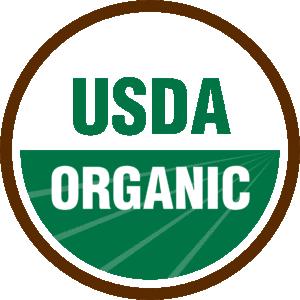 |
U.S. Department of Agriculture, National Organic Program | The farm adheres to the standards in the National Organic Program. | The farm doesn’t use harmful chemicals and the food is safe. |
| Regenerative Organic |  |
Regenerative Organic Alliance | The farm adheres to the guidelines in the regenerative organic program. | The farm doesn’t use harmful chemicals and the food is safe. Stricter standards than USDA Organic. |
| Certified Naturally | 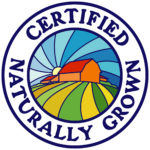 |
Certified Naturally Grown | The farm meets standards to be certified natural by the farm’s peers. | The farm doesn’t use harmful chemicals and the food is safe. |
| Homegrown by Heroes |  |
Farmer Veteran Coalition | The farm is owned by a military veteran. | The farm has classic military values such as honor and sacrifice. |
| Certified Humane | 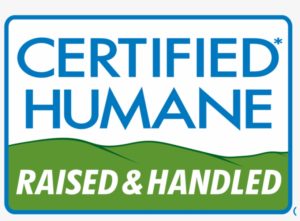 |
Humane Farm Animal Care | The farm’s livestock is raised according to standards of care. | The farm values caring for animal welfare. |
| Food Justice Certified | 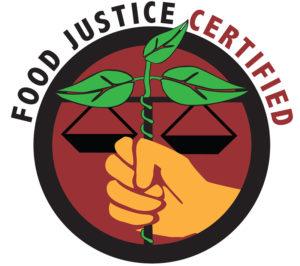 |
Agricultural Justice Project | The farm treats its employees and partners fairly, as set to a standard. | The farm values social justice and workers’ rights. |
| Certified B Corporation | 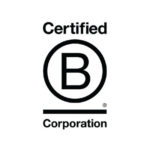 |
B Lab | The business meets social responsibility standards and is mission-driven, not profit-driven. | The business cares about its community and impact in the world. |
| GAP (Good Agricultural Practices) Certification |  |
USDA – Agricultural Marketing Service (in the United States) | The farm produces, packs, handles, and stores product to a food safety standard. | The farm cares about the health of its customers and the quality of its product. |
Colors
In our society, colors have meaning all on their own. We talk about warm colors and cool colors. People associate red with fire, anger, and danger. Yellow is associated with happiness (the smiley face) and lightness. Green is used to represent life, earth, growth. Blue can be sad, but also calm (Chapman, 2010).
Smashing Magazine did a great online article on color theory and meaning (updated in 2017), but it’s just one of a whole world of resources on color that you can find online.
To test color theory, look the classic USDA Organic logo. It has a dark, muted green and a lighter accent green, plus a brown circle around it. Green and brown. Can you imagine the same logo in red and yellow?

The Four Season Farm website is a combination of muted greys, greens, and blues. The Soul Fire Farm website is black, white, green, and red. The former is using color to show its tradition, the latter its strength.
Other Branding Tools
Ultimately, everything your farm business does will connect to your brand. Your brand is your reputation, and while you have control over how you communicate, your brand identity lives in the heads of your customers.
When thinking about your brand, notice how it affects:
-
- Your product choice – can you be a community farm but only grow high-end, expensive microgreens?
- Your sales venues – can you maintain your local identity if you sell to national distributors?
- Your appearance – what story does your outfit tell when you are at your farmers market stand?
- Your packaging – how does tying flowers with twine differ from presenting them in a cellophane wrap?
- and so much more…
To leave you with one example, Marvel Comics is the owner of the X-Men franchise. The overarching story for X-Men is how they want mutants (with superpowers) to have the same civil rights as humans. At one point, to avoid import taxes on the toys, Marvel went to court to have the X-Men action figures classified as non-human. Doing this deeply hurt their fan base, who saw the act as blatantly hypocritical. In order to save money, Marvel went “off-brand” from the story of their characters, i.e., the story of their product (Sriskandarajah, 2011).
Creating a Style Guide
After you have worked out all the ways you will be telling your brand story, write it down. In the same way that you would chart the Standard Operating Procedures for milking goats or harvesting chard, record that information for future use. Pull it all together in one living document so that everyone on the farm understands the pieces. This is often called a style guide.
You can visit Hubspot for 21 Brand Style Guide Examples for Visual Inspiration, by Karla Cook.
Make sure that the farm brand is something that all the folks involved in the farm have access to.
Brand Considerations in Different Market Channels
Your brand carries your farm story to your customer, but that journey can be different based on the type of market channel you sell your product through. Direct markets, where you interact directly with the end-user of your product, are where you have the most control. Examples include your farm stand, a farmers market, a CSA share, and even an online sale. Intermediated Markets are one-stop market channels such as food hubs, restaurants, independent groceries and food coops, and institutions. Your product goes from your farm to the intermediary, who will then pass it on to the end-user. Wholesale markets, where your product travels through multiple steps before arriving at the end-user, offer the least means for you to communicate your farm brand.
In Direct Markets, every tool listed in this publication is at your disposal. You can put the logo up on a farmers market stand. You can spend the extra two minutes chatting up a customer who wants to know what farm life is like. Remember, your customer may also have expectations of you. If someone is coming to your farm to pick up milk, they may want to have the chance to interact with you or see the cows. Long story short: in direct markets, you have lots of communications control.
When you are selling through Intermediated Markets, things get more vague. You will need to talk to your intermediary about how they are selling your product. Will the grocery store let you put up a large display with pictures of your farm? Will the restaurant highlight you on their menu? The major question for you to ask here is: how can I help my vendor sell my brand?
Finally, when selling through Wholesale Markets, you may have little to no control. If you are selling a commodity crop or if you are selling produce by the ton, your product may end up being combined with many other farms and your brand may be lost completely. Alternatively, you may be able to sell a product pre-wrapped or boxed with your logo on it. In that case, your communication methods may be as little as your logo – a little mark on a product that needs to carry the whole weight of your story. Consider talking to your wholesaler about what they do to maintain your brand identity.
Conclusion: Content and Style
My father, a marketing strategist for IBM for 30 years, used to say: everything in life is half style and half content. You can have the best product in the world, but it will just sit on the shelf without style. And if you are just a show, but do not have the content to back it up, people will recognize you as empty and a waste of time.
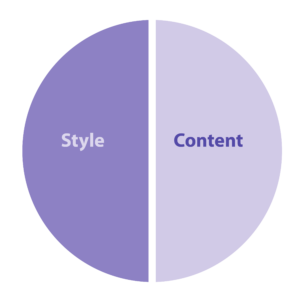
Telling the story, balancing your farm product with style, and meeting your customer is an art. But like any art, it is something you can learn. And it takes time. Your farm brand, based on your farm business, will evolve with you over time. Rebranding is possible. Shifting meanings is possible.
By leading with your brand, you will help your customers tell their own stories and your business will thrive.
References
Angulo, Natalia. 2015. Does values-based marketing really work? Marketing Dive. November 18.
Beckwith, Sue and Mike Morris. 2019. Beyond Fresh: A Food Processing Guide for Texas Farmers. ATTRA publication. National Center for Appropriate Technology, Butte, MT.
Chapman, Cameron. 2010. Color Theory for Designers, Part 1: The Meaning of Color. Smashing Magazine. Jan 28.
Cook, Karla. 2020. 21 Brand Style Guide Examples for Visual Inspiration. Hubspot. Feb 6.
Davey, Lynn. 2008. The Construction of Knowledge: A Cognitive Perspective on How We Know What We Know. Frameworks Institute. October.
Leopold, Aldo. 1949. A Sand County Almanac with Essays on Conservation from Round River. Ballantine Books, New York, NY.
Levy, Sidney J. 1959. Symbols for Sale. Harvard Business Review. Vol. 37, No. 4. p. 117-124.
Medical News Today. 2020. What Are the Health Benefits of Kale?
Morones, Hilda. Updated by Kelly Morr. 2019. The 7 Types of Logos (And How to Use Them). 99 Designs.
Sirgy, M. Joseph. 1982. Self-concept in consumer behavior: A critical review. Journal of Consumer Research. Dec. p. 287-300.
Sriskandarajah, Ike. 2011. Mutant Rights. Radiolab Podcast. WYNC Studios. December 22.
Further Resources
Books
Brand Style Guide Kit: How to Build and Effective Brand Style Guide (+ Templates to help you do it) (E-Book), from HubSpot and Venngage.
Free download if you give your name, e-mail, company, etc.
Direct Market Success: A Farmer’s Guide to farmers market, CSA, farmstand, online and restaurant sales, 1st edition. 2016. Edited by Jim Slama, Bob Benenson, and Atina Diffley. Family Farmed, Chicago, IL.
How to Build a Brand: A Comprehensive Guide (E-Book), from HubSpot and Rebrandly.
Free download if you give your e-mail.
Organizations and Businesses
Frameworks Institute, Washington, D.C.
This nonprofit think tank looks into how mental frames affect our communication.
Tim Young runs a company that offers paid marketing services to farmers, but a lot of what he offers is free online.
Corrina Bench is a farm-marketing consultant with many paid courses, but offers a free podcast and a large CSA Marketing discussion group on Facebook.
Charlotte Smith offers courses in farm marketing through her company and also offers a great deal of information for free.
HubSpot is an online marketing-services provider that offers a great deal of material for free, including e-books and templates. They release an annual Guide to Branding.
Appendix A: Making Meaning from Objects
To make meaning out of objects, we start with the physical item first and draw possible meanings from it. For example, a car can mean “freedom of the open road,” “speed,” or “status.” A pen can mean “writing,” “language,” “communicating with someone far away.”
In short, we are ascribing intangible qualities to tangible objects and that gives them meaning.

We are answering the question, “So What?” Why is the car important? The car is black. So what?
Why do I need a pen? The pen belongs to my sister. So what?
Identifying Intangibles and Meaning
Red Wagon
Read the following passage and keep an eye out for meaning:
“Jimmy has a little red wagon. It is solid metal and fading from age. It squeaks and bumps over his gravel driveway as he loads it with rocks and sticks and toys. He runs around the neighborhood, setting up his command post, using a twig as a radio antenna. Then, with a flip, the toys are tossed out and the wagon becomes a racecar cornering the great raceways of Germany. Then, it’s a boat that he uses to cross a dangerous river. Jimmy plays with his red wagon every day, rain or shine. It is his favorite toy.”
-
- Identify the important tangible.
- List the intangibles in the passage.
Creating Meaning
Pick an item from the list and give it some meaning. If you find yourself stuck, make the item more specific. For example, bottle can become beer bottle. You can also think of yourself as a playwright or a movie director. What does it mean if the focus lands on the object for a moment?
Item 1: (pick one)
| PHONE | BOOK | FIRE | BOTTLE |
List intangibles:
Feel free to practice this again with a different object, either from the list or not.
Now, let’s repeat the activity, but with farm products.
Item 2: (pick one)
| YOUR BROCCOLI | YOUR EGGS | YOUR GOATS | OTHER |
List intangibles:
If you find yourself getting stuck, think about what you’d say if you were to make the sale at a farmers market: “Buy my product because…” Your broccoli has meaning because it…
Appendix B: Capturing the Farm Meaning
To create a farm brand, the idea is to pull intangibles out of the farm the same way you pull intangibles out of a product to sell it. Try to find the answer to the question “so what?” for your farm business? To help answer this question, here are four different techniques for trying to develop a farm brand. Pick one and give it a try. Combine the answers with another activity and see how things change.
Using Whole-Farm Planning
One way to capture the meaning of the farm is to engage in whole-farm planning. Call the ATTRA hotline to schedule a consultation with an Agriculture Specialist or reach out to your state university Cooperative Extension Service. As you go through your whole-farm planning process, use the space here to take notes about personal and family goals and dreams. Is there something there you can use to help define the meaning of your farm?
Farm Goal:
Notes:
The Farm Story
Take as much time as you need to write out the farm story here. Use extra paper if necessary. How did you get started? Why did you get started? Who was involved? How did the name come about? What was the first farm product?
After stepping away from your writing for a while, return to what you have written and underline what resonates with you. Pull out words and ideas that you feel are important. Then refine. Can ideas be combined? Ranked? What is most important? Use the space below to write down what your farm story has shown you about the meaning of your farm.
If the Business were a Person…
Describe that farm business as if it were a person. What attributes and descriptors would you use? Personifying the farm like this can help you get a sense of the image you want to convey. Pull out “personality” characteristics and list them, such as: friendly, quaint, hip, fun-loving, etc. Narrow the list down to the top few.
Adjectives
Try and describe the farm in three adjectives. It may be necessary to start with a brainstorm and a listing of all possible adjectives to describe the farm. Even so, the goal is to refine down to the two or three adjectives that best match the meaning of your farm. It may be tempting to pick three broad adjectives, but specificity is better. Eliminating adjectives does not mean that they do not apply to your farm, but rather that you will not use them as a pillar of your branding.
Appendix C: The Marketing Avatar
The purpose of this activity is to give some humanity to your marketing efforts. Answer the following questions about a fictitious or real customer of yours (or something along the spectrum between the two). Repeat the activity two or three times for different people. The idea is that each avatar will represent a segment of your market.
Demographics
Name:
Age:
Gender:
Marital Status:
Children:
Home Town:
Occupation:
Salary:
Education Level:
Other:
Other:
Goals and Values
What does this person want in life?
What is this person committed to?
Goals and Values
What does this person want in life?
Challenges
What challenges does this person face?
What keeps this person up at night?
Barriers to Sale
What stops this person from purchasing from me?
What objections does this person have to my products or my brand?
Sources of Information
Where does this person get their information? Books? Magazines? Websites? Podcasts? Social Media Influencers? Etc.
What locations do they frequent? Stores? Studios? Coffee Shops? Schools? Etc.
It often helps to have a picture of this person to help focus you.
Appendix D: What’s YOUR Brand?
This exercise is another to help you work on your farm brand creation. It was originally published in Beyond Fresh: A Food Processing Guide for Texas Farmers by Sue Beckwith and Mike Morris.
Answer the following three questions. They will help you share your story in a succinct, engaging way, which is the foundation of your brand:
1. What are three factors that set your farm apart?
-
- Are you the local innovator, always trying a new variety?
- Has your family been farming in the same place for generations?
- Do your religious beliefs inform your farming?
- Is your farm certified organic? A wildlife sanctuary?
- Were you a chef before you were a farmer?
- Did health concerns lead you to farming?
2. What words describe your business philosophy?
Examples:
-
- We value integrity and honesty in our work.
- Our enterprise will be useful to farmers, customers, and community for the long term.
- We value hard work, drive, efficiency, and productivity.
- We want to work with people who are nice, honest, and willing to collaborate openly.
In thinking of words and phrases that describe your own business philosophy, you may find it helpful to check value words in the list on the following pages.
3. Describe your farm using active, tangible descriptors.
Write a few sentences.
Example: We create unique delicious products from more than 100 varieties of fruits, vegetables, and herbs that are grown on our certified organic, community-based farm. All ingredients in our products are grown using sustainable farming methods that improve the health of our soil and environment. We strive to operate our business honorably, with creativity, and with the utmost respect for the Earth and those our products and services touch.
| Abundant Accepting Accessible Accomplished Accurate Active Adaptable Adept Adorable Adroit Adventurous Aggressive Agile Agreeable Alert Altruistic Ambitious Amusing Appreciative Approachable Appropriate Articulate Assertive Astute Assured At ease Attentive Attractive Audacious Available Aware Balanced Beautiful Belonging Benevolent Biodynamic Bold Brave Bright Brilliant Buoyant Calm Candid Capable Caring Careful Centered Challenging Charitable Charming |
Diverse Dominant Down to earth Driven Dutiful Dynamic Eager Ecological Economical Ecstatic Educated Effective Efficient Elated Elegant Emerging Empathic Enchanting Encouraging Endearing Enduring Energetic Enjoyable Entertaining Enthusiastic Environmental Ethical Excellent Exciting Exhilarating Expedient Experienced Experimental Expert Exploratory Expressive Extravagant Exuberant Fair Faithful Famous Family-oriented Fascinating Fashionable Fast Favorite Fearless Felicitous Fierce Firm |
Inspirational Instructive Integrated Integrity Intelligent Intense Interested Intimate Intrepid Intuitive Inventive Invested Involved Joyful Judicious Just Keen Kind Knowledgeable Leader Learning Liberating Lively Logical Long-lived Long-standing Loving Loyal Lucid Lucky Luxurious Masterful Mature Mellow Meticulous Mindful Modest Moral Motivated Moxy Mysterious Natural Neat Neighborly Nervy Nimble Noble Nurturing Obedient Off the charts |
Relaxed Reliable Religious Remarkable Resilient Resistant Resolute Resolved Resourceful Respectful Responsive Restrained Reverent Revolutionary Right Rigorous Rock solid Sacred Sacrificing Satisfying Secure Self-controlled Selfless Self-reliant Self-sufficient Sensitive Sensual Serene Sexy Sharing Shrewd Significant Simple Sincere Skillful Smart Solid Sophisticated Sound Speedy Spirited Spiritual Spontaneous Stable Stealthy Strong Structured Stylish Subtle Successful |
| Cheerful Clean Clever Clear-minded Comforting Committed Compassionate Complete Compliant Composed Concentrated Concerned Confident Congruent Connected Conscious Consistent Constant Constructive Content Contributing Controlled Convivial Cool Cooperative Cordial Correct Cosmopolitan Courageous Courteous Creative Credible Cunning Curious Daring Decisive Deep Deep-rooted Delightful Dependable Detached Determined Developing Devoted Devout Dexterous Dignified Diligent Direct Disciplined Discreet |
Fit Flexible Flowing Fluent Focused Fortuitous Frank Free Fresh Friendly Frugal Fun Generous Giving Glorious Good Graceful Grateful Gregarious Grounded Growing Happy Hard-working Harmonious Healing Healthy Heartwarming Hearty Helpful Heroic High-achieving Holy Holistic Honest Honored Hopeful Hospitable Human Humane Humanistic Humble Humorous Imaginative Impactful Impartial Independent Industrious Ingenious Innovative Inquisitive Insightful |
Off the charts Open-minded Open to all Optimistic Orderly Organic Organized Original Outlandish Outrageous Passionate Peaceful Perceptive Perfect Persevering Persistent Persuasive Philanthropic Pioneering Playful Pleasant Poised Polished Popular Potent Powerful Practical Pragmatic Precise Prepared Prescient Present Private Proactive Productive Professional Profitable Prosperous Prudent Punctual Pure Quick Quiet Ready Realistic Reasonable Recognized Refined Regenerative Regular Rejuvenating |
Sufficient Suitable Superior Supportive Surprising Sustainable Sympathetic Synergistic Thankful Thorough Thoughtful Thrifty Timely Tolerant Touching Traditional Tranquil Transcendent Transformative Transparent Trustworthy Truthful Understanding Uniform Unique Unstoppable Up to date Useful Varied Victorious Vigorous Virtuous Vital Vivacious Warm Watchful Wealthy Well known Well regarded Wide-ranging Willful Willing Winning Wise Witty Wonderful Youthful Zealous |
Appendix E: Brand Development in 9 Easy Steps
This exercise is another to help you work on your farm brand creation. Specifically, this will walk you through a series of questions that can turn your farm business decisions into an identity for the business. It was originally published in Beyond Fresh: A Food Processing Guide for Texas Farmers by Sue Beckwith and Mike Morris.
-
- The specific product, product line, service, farm, or other business I’m branding is:
- We will offer these products and services:
- These are the core values embodied by our farm, product, service, co-op, group of farmers, etc.
- This is our mission, what we are trying to accomplish:
- This is what we specialize in, what sets us apart:
- This is our target market, the group our products and services affect:
- This is our tagline and the message it sends to customer prospects:
- If our farm/company/product line were a person, this would be its personality or character (e.g., innovative, creative, energetic, sophisticated):
- Use the personality (step 8) to build a relationship with target market in step 6. How does that target audience react to the personality? What characteristics will stand out? What characteristics and qualities get the attention of your prospects?
Farm Branding: Selling Your Products Through Story
By Daniel Prial, NCAT Community Foods Specialist
Published April 2021© NCAT
IP608
This publication is produced by the National Center for Appropriate Technology through the ATTRA Sustainable Agriculture program, under a cooperative agreement with USDA Rural Development. ATTRA.NCAT.ORG.

